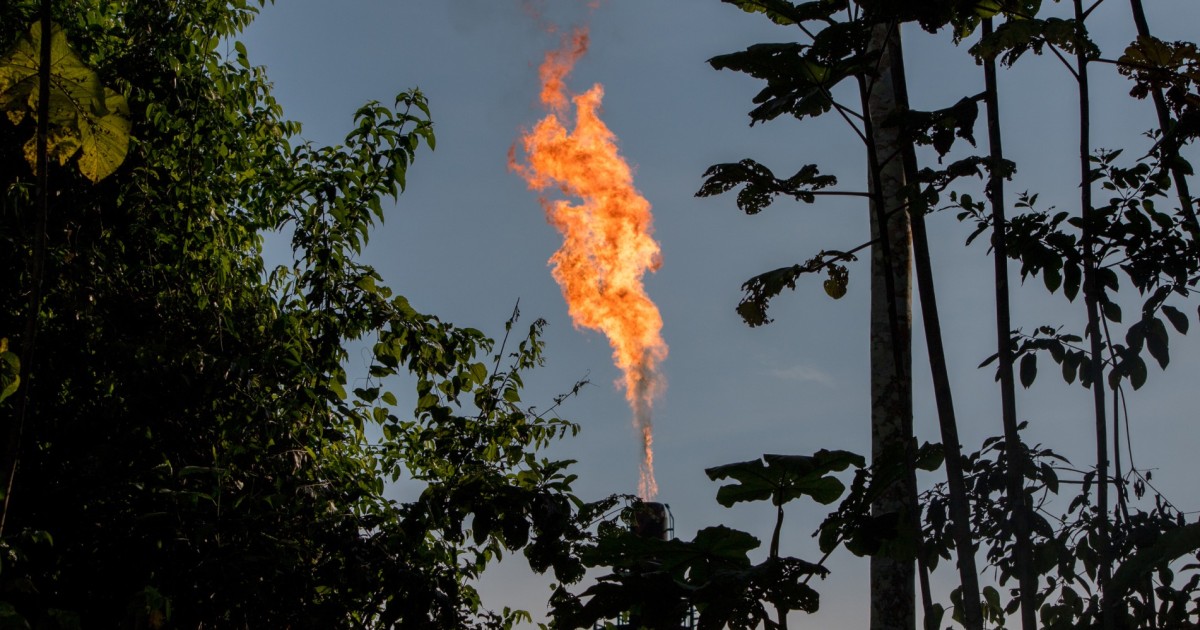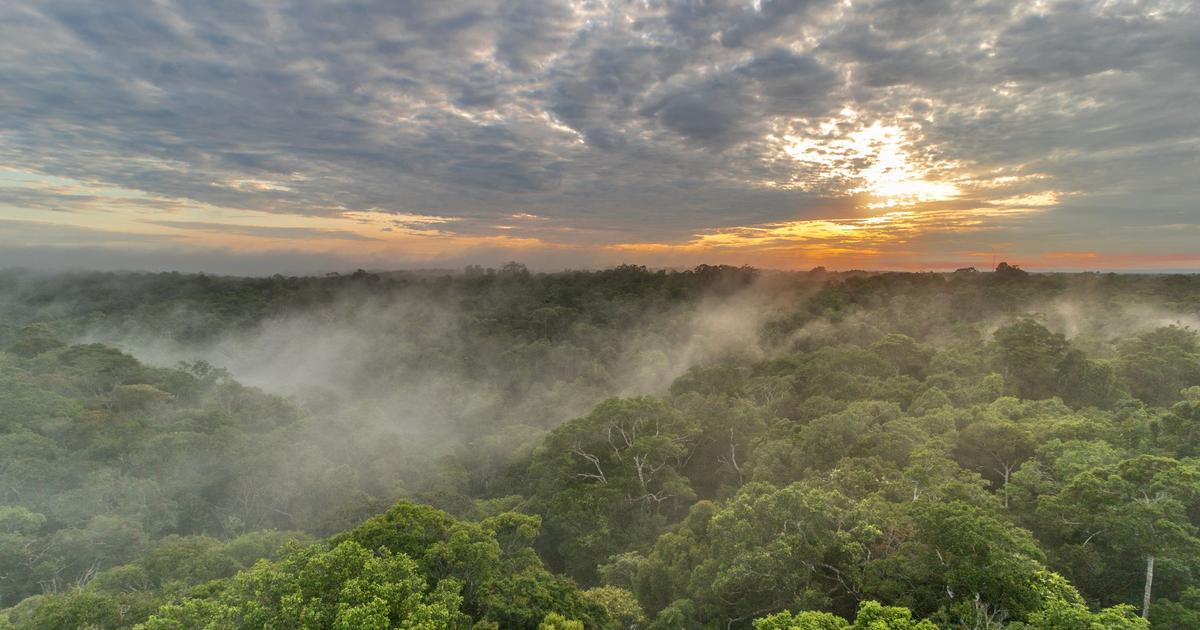Rich Schapiro, Christine Romo and Santiago Cornejo -
NBC News
This article was produced in association with the Rainforest Investigations Network of the Pulitzer Center.
YASUNÍ NATIONAL PARK, Ecuador - Bulldozers thunder after sunrise, knocking down huge amounts of trees in this remote and extraordinary region of the Amazon rainforest.
It's a place where giant otters patrol waterways and endangered yellow-bellied spider monkeys swing from tree to tree.
There is a dazzling variety of birds, more than 600 species, that nest in the dense foliage.
It is a territory inhabited by more than 60 types of snakes and 140 different species of amphibians such as toads and frogs.
Yasuní National Park is home to one of the most diverse plant and animal reserves on the planet.
But beneath this 3,800-square-mile stretch of forest lies another kind of treasure: oil.
More than one billion barrels.
Over the past 50 years, oil companies have extracted huge amounts of crude from the Amazon, leading to the destruction of the rainforest that is crucial to curbing climate change and endangering the indigenous tribes who depend on it.
[A miner found gold and alerted the others: flotilla of illegal miners causes alarm in Brazil]
A state oil company that outsources its field operations to Chinese companies is now building a highway to reach what will be a new section of wells deep in the Yasuní.
"It pains me to see how little of our rainforest is left in this protected area
," Nemo Guiquita, a leader of the Waorani tribe, told NBC News during a boat trip through the national park.
"We should be fighting to protect our rainforest in Ecuador, but instead they are granting more oil concessions," he added.
The oil extracted from the Yasuní and the vast Amazon is exported around the world, but on average 66% goes to the United States and much of the oil reaches a particular state: California, according to a new report shared exclusively with NBC News.
The lighter of an oil processing plant in the rainforest of Ecuador's Yasuní region.Carlos Noriega for NBC News
The report by environmental groups Stand.earth and Amazon Watch revealed that last year, on average, one in seven tanks of gasoline, diesel or jet fuel that were stocked in Southern California came from the Amazon rainforest.
Among the top 25 corporate consumers are companies such as Costco, PepsiCo and Amazon, according to the research.
"This is no longer one of those situations where we are supposed to feel sympathy for a crisis that is happening elsewhere," said Angeline Robertson, Stand.earth principal investigator and lead author of the report.
"It is happening in California and is related to the destruction of the Amazon," he added.
The rise and fall of oil
The extraction of crude oil in the Ecuadorian Amazon began in the 1960s with the promise of generating prosperity in that coastal South American nation.
As if it were a national hero, the symbolic first barrel of oil was paraded through the streets of Quito, the capital city.
The Ecuadorian economy skyrocketed over the next decade.
But by the 1990s, the oil boom had faded and the country entered a severe recession, leading to a series of deals with foreign oil companies and, over time, mounting debt.
Ecuadorian President Guillermo Lasso, who took office last May, promised to double national oil production.
Perhaps no place could be more affected than Yasuní National Park.
A house in the Llanchama community, in Yasuní National Park.Carlos Noriega for NBC News
The park in eastern Ecuador, at a confluence of the Andes mountains, the western Amazon basin, and the equator, is roughly the size of Rhode Island and Delaware combined.
It contains more varieties of trees in a single hectare (2.5 acres) than the United States and Canada have.
Yasuní is also home to the Waorani people, as well as two isolated tribes living deep in the forest: the Tagaeris and the Taromenane.
Oil exploration began in the 1970s, but in 2007 the government of Rafael Correa proposed a novel plan to protect the rainforest from drilling.
He called on the international community to donate around 3.5 billion dollars, about half of the income that Ecuador estimated it would have obtained from the extraction of oil found under the soil of Yasuní.
But the plan was abandoned six years later, after Ecuador raised less than 10% of that figure.
"The world has failed us," Correa said in 2013 when he announced the lifting of the moratorium on oil drilling in Yasuní.
According to environmentalists, the move to drill hundreds of new wells in the national park requires the construction of roads and other infrastructure projects that could accelerate deforestation.
Initial road construction within the park is now less than 1,300 feet from the protected area that was designed to preserve isolated tribes, report investigators say.
Searching for new oil and cutting down forests to get it is a recipe for climate disaster. "
Kevin Koenig, Principal, Amazon Watch
Kevin Koenig, director of climate and energy at Amazon Watch, noted that forests of this type play a vital role in mitigating climate change.
Forests absorb huge amounts of carbon, which helps slow the rate at which carbon dioxide builds up in the atmosphere.
"Searching for new oil and cutting down forests to get it is a recipe for climate disaster," Koenig said.
"It's kind of a double whammy and everyone should be really concerned."
Gas flares
For years, Nemo Guiquita, the Waorani leader, has fought the expansion of oil extraction on her tribe's ancestral land.
He said his grandmother, Nayuma, was the first Waorani to come into contact with the outside world 60 years ago.
"For us, the rainforest is our home," said Guiquita, "it is our life, our pharmacy, our everything."
Nemo Guiquita, a Waorani woman and nature rights activist, rested in a hammock in the community of Llanchama.
Carlos Noriega for NBC News
More than 400 gas lighters dot the landscape in the Ecuadorian Amazon.
These flames send clouds of chemicals into the air from the combustion of natural gas produced in oil wells.
In January, an Ecuadorian court ordered oil companies to stop using gas lighters after a group of girls from the Amazon filed a lawsuit alleging that the flares contaminated the air and water in the area and contributed to the fact that more than 200 cases of cancer will occur in your community.
Javier Solís, a lawyer representing one of the local communities, said the government has not yet set a date for the removal of the old lighters.
Solís accompanied an NBC News cameraman to an area of the forest outside Yasuní to see what he described as one of the biggest oil flares in the Amazon.
"The contamination can reach a circumference of 300 meters [330 yards] and this affects the groundwater and rivers used by nearby communities," Solís said.
Javier Solís, a lawyer for the El Edén community, poses for a portrait in front of the lighter of an oil processing plant.Carlos Noriega for NBC News
In recent years, the road being built in Yasuní has gone several kilometers further into the forest, according to Pedro Bermeo, a spokesman for YASunidos, a group created to protect the park.
Risking arrest, members of Bermeo's group flew a drone over the area in July and captured images of bulldozers digging through the rainforest.
"I always think, 'What if we find oil under Quito?" Bermeo said, "would we displace the people of Quito to extract the oil? Of course not. But when it comes to the jungle and it involves indigenous communities, no there is no respect or consideration for their health. "
Bermeo is well aware of the economic forces driving the expansion of oil extraction in the Amazon.
[The COP26 draft climate agreement calls for ending public aid for fossil fuels]
The Ecuadorian government has a debt of more than 18,000 million dollars with China, according to a database managed by Boston University and Inter-American Dialogue, an analysis center, and oil revenues are essential to pay the loans.
Ecuador granted oil exploration rights in and around Yasuní National Park to a consortium of Chinese state oil companies despite fierce opposition from indigenous and environmental groups.
When it comes to the jungle and involves indigenous communities, there is no respect or consideration for their health. "
Pedro Bermeo, YASunidos spokesperson
"The companies that make a profit are the Chinese oil companies," Bermeo said.
"The Ecuadorian oil companies subcontract to the Chinese for exploration, drilling and infrastructure. They are the ones who make money here."
Chinese oil companies Andes Petroleum and PetroOriente did not respond to a request for comment.
The Ecuadorian Embassy in Washington also did not respond to a request for comment.
Excavators in the Yasuní National Park clearing forested areas in order to build new roads for the exploitation of oil.
YASunidos, an organization that works to protect the Yasuní and the indigenous people who live in the jungle, captured these images in July 2021.
Where does the oil go
Ecuador is not the only South American country that exports oil from the Amazon, but it dominates that market, according to the report consulted by NBC News.
Colombia and Peru accounted for about 7% of the total volume of crude oil exported from the Amazon worldwide.
Ecuador accounts for the other 93%, according to the report (Brazil and the other South American countries that share the Amazon territory were not found to export the oil found in their subsoils).
Last year alone, some 70 million barrels of oil from the Ecuadorian Amazon rainforest were exported to the United States, making it by far the world's largest consumer.
Panama ranked second (with almost 22 million) followed by Chile (13 million) and China (almost 10 million), according to the report.
California accounted for the consumption of nearly 56 million barrels, far more than the other five states that also bought that oil: Texas (6 million), Louisiana (6 million), Mississippi (0.5 million) and Washington (0.4 million).
In a statement, the California Environmental Protection Agency said the state is investing more than $ 15 billion in its climate agenda, including $ 4 billion to accelerate the transition to zero-emission vehicles.
"We cannot sacrifice the livability of our planet or the survival of vulnerable indigenous communities for a dying industry
," the agency said.
"This report accurately illustrates why California must eliminate dependence on fossil fuels, whether they come from critical regions like the Amazon or near homes and schools located right here in the state," he added.
Investigators for the report tracked shipments of oil extracted under the Amazon to the United States and beyond, by reviewing records from the United States Energy Information Administration (EIA), the United Nations Comtrade database, and databases. import / export data for Ecuador, Colombia, Peru, Brazil and the United States.
The researchers also reviewed a number of different sources - including federal and state government databases and company reports - in order to calculate fuel consumption estimates for the amount of Amazonian oil that was used by the targeted US companies. in the report.
About half of the oil extracted from the Amazon that was exported to California went to three refineries in and around Los Angeles, according to the report.
Gasoline tanker trucks being transported on the Napo River, in Yasuní National Park.Carlos Noriega for NBC News
California drivers fill their gas tanks with oil extracted from the Amazon at gas stations operated by big brands like Marathon, Chevron and Shell.
The top-consuming brand in 2020 was Marathon (339 million gallons), according to the report, but it still lagged behind unbranded gasoline (479 million).
Motorists also buy Amazonian fuel at supermarket gas stations at places like Costco, Safeway and Walmart.
These companies also use them for their fleets.
Last year, Costco was the top consumer of fuel extracted from the Amazon (19 million gallons), according to the report.
Last year, the major airlines operating in California consumed a total of 123 million gallons of jet fuel extracted from Amazon oil.
According to the investigation, the top consumer was American Airlines (31 million gallons) followed by United (30.05 million gallons) and Delta (30 million gallons).
PepsiCo (with 4 million gallons) was the main consumer of diesel extracted from the Amazon among food and beverage distribution companies.
Among parcel companies, Amazon (13.3 million gallons) narrowly beat UPS (13.1 million gallons) and FedEx (12 million).
The report urged corporate leaders not to call for a new oil expansion in the Amazon and to set "aggressive targets for the use of electric vehicles and other strategies designed to reduce the consumption of fossil fuels."
NBC News contacted all of the companies mentioned in this report.
Delta was the only one to respond, saying that it is working to move from aviation fuel to sustainable aviation fuel and expects to convert it to 10% of its total fuel supply by 2030.
Ed Hirs, an energy professor at the University of Houston, said he is not surprised that such a large amount of oil from the Amazon ends up in California given its proximity.
"Maybe it's just the cost of transportation," Hirs said, "it's seven or eight days to California" from Ecuador, "instead of weeks from the Middle East."
Hirs said the report underscores a stark reality of the global oil market: Even if California stopped consuming crude from the Amazon, another country would take its place.
"I can't argue with what they are talking about in terms of environmental damage and problems," Hirs said.
"Is it a problem? Definitely.
Can California do something about it? No. For another 50 cents a barrel, that oil would go elsewhere
, he added.
Robertson said he knows it would be unrealistic for California to stop using Amazon oil entirely, but hopes that government officials and corporate leaders will take steps to reduce its dependence as part of an overall strategy to reduce the use of fossil fuels.
"It is within the realm of what is possible and is part of the necessary measures," said Robertson.
"It should become central to California's climate crisis strategy."
Santiago Cornejo reported from Ecuador. Rich Schapiro and Christine Romo reported from New York.






/cloudfront-eu-central-1.images.arcpublishing.com/prisa/UYB5LX3DDBAQTJNDI5EKYZLHEM.jpg)




/cloudfront-eu-central-1.images.arcpublishing.com/prisa/KMEYMJKESBAZBE4MRBAM4TGHIQ.jpg)


/cloudfront-eu-central-1.images.arcpublishing.com/prisa/EXJQILQR5QI7OMVRTERD7AEZAU.jpg)
